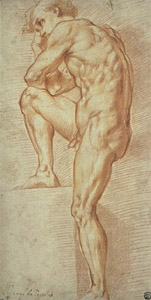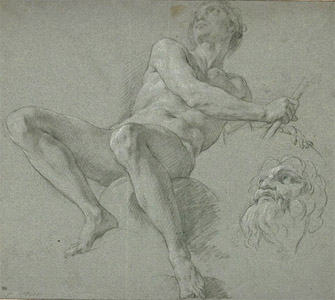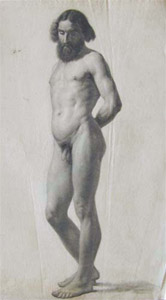
-
PHILOSOPHY
•
DIRECTOR
•
CURRICULUM
•
GALLERY
•
NEWS


|
|
|
|||
| 16th century drawing by Pontormo - Heroic Qualities | 18th century drawing by Lemoyne - Decorative Characteristics |
19th century drawing by Anonymous - Realistic Emphasis |
THINKING OF DRAWING AS AN ACT OF INTELLIGENCE
There is an old saying that we use only 10 percent of our brains.
One might notice how much emphasis is placed on working from the plaster cast as the foundation of training at this school. This method allows for the study of form (and even color to a degree) under controlled circumstances, while indirectly influencing the receptive mind to more advanced concepts present in the original work of art. Learning certain fundamentals about drawing and painting in this way follows the venerable tradition which eventually became a required part of training in the 19th century French Academy.
One might also notice how much more gradually working from the life model enters into the progression of our teaching, especially compared to many modern schools. There are several reasons behind this decision, and time will tell what this traditional approach produces in our age. The practice of studying from the nude model is an ancient method for training artists - one that somehow survived the collapse of art training in the 20th century and continues in its many fragmented translations today. It often seems that any unclothed model of any shape in any relaxed attitude will do in most modern circles. The demonstration of "significant form," that great common denominator behind so much use of the human figure in all periods of art, is conspicuously absent in most modern work.
We learn by comparisons. When the contemporary student responds to the history of western art (if at all), there is likely to be some resonance with the unadorned realism of the 19th century because it is closer to our time. Older traditions celebrating sacred or pagan heroes based on an architecture of geometry and design seem to be an almost lost language. The ability to divide space and ornament - the foundation of all fine art - is, at best, only dimly sensed in the rush to regain a basic mimetic ability. And in the silent works left behind by our greatest ancestors and teachers, the Greeks, the lessons are still within view if we are alert to the possibilities of balancing realism with idealism.
Our philosophy is devoted neither to pure history nor pure preservation, but to the belief that if we are to continue making new works of any real value, the spirit and quality of past master works must inform our own. In taking the time to absorb magic from the history of art, and developing the habit of expecting excellence in every stage of development, it is our goal to animate and guide not only our life studies but everything we undertake that defines us as artists.
In his first lecture to London's Royal Academy, Lord Leighton addressed the subject of the 19th century's preoccupation with acute optical realism:
"This movement has evidently great elements of good; it is the outcome of sincerity...and more sympathetic insight into human nature; but it has also its alloy; for an excessive absorption of the attention in the most superficial aspect of things tends to the over-development of the simply imitative faculty, which is the lowest gift of the artist, at the cost of his aesthetic faculty and of his imagination, which are the noblest, and tends therefore also to triviality and loss of that which gives to Art its high place amongst the elements of civilization."


